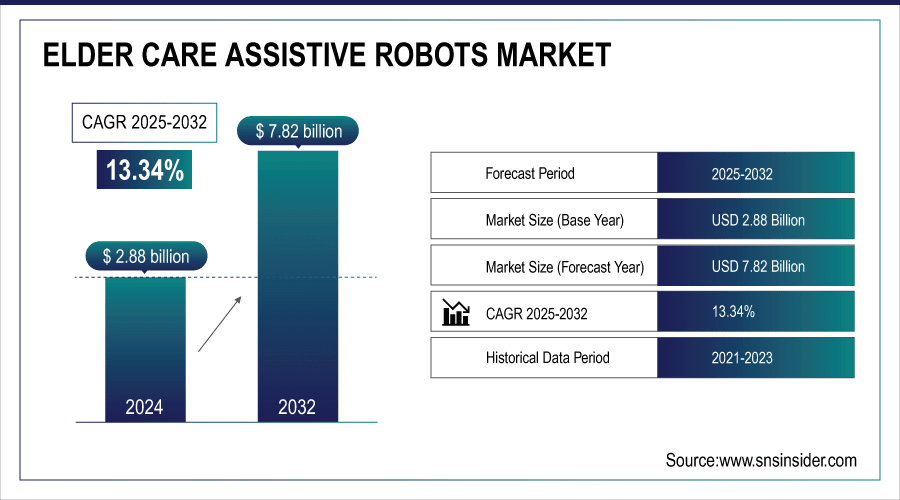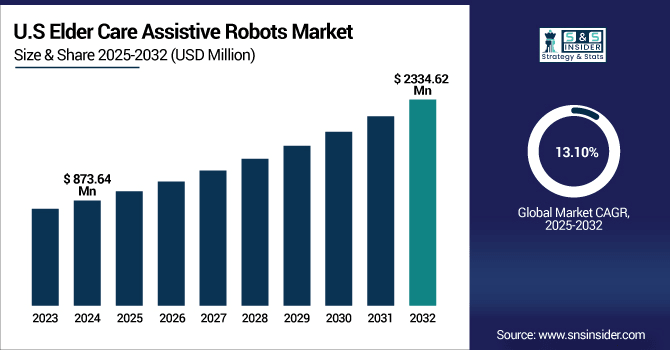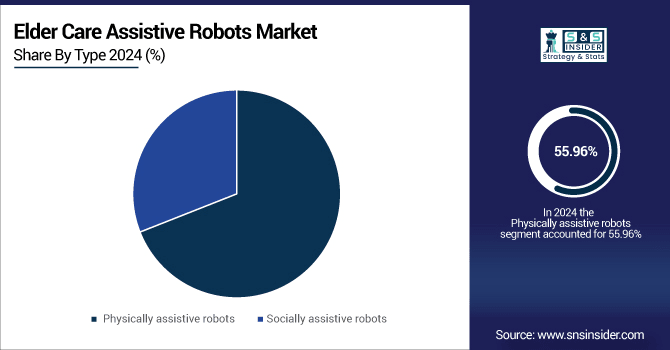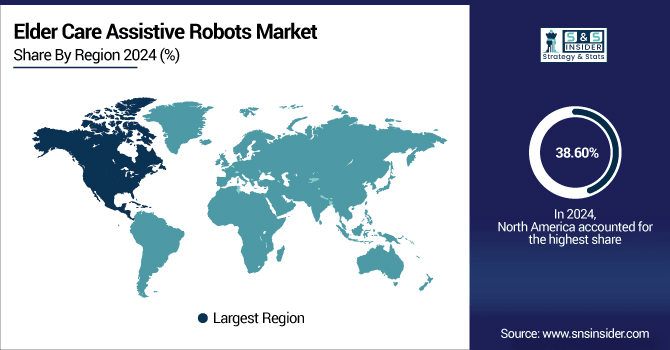Elder Care Assistive Robots Market Report Scope & Overview:
The Elder Care Assistive Robots Market size was valued at USD 2.88 billion in 2024 and is expected to reach USD 7.82 billion by 2032, growing at a CAGR of 13.34% over the forecast period of 2025-2032.
The emergence of Artificial Intelligence (AI) driving the global elder care assistive robots makes real-time health monitoring, adaptive learning, voice interaction, and personalized care to revolutionize the AI-aided elder care market. Robots with AI capabilities can identify falls, measure vital statistics, help people move around, and simply keep them company, which all contribute to the well-being of the elderly. Trend 10: emotion-sensing robots, AI-infused home automation, remote diagnostics, and multilingual support. The global elder care assistive robots market is expanding at a breakneck pace, as AI renders robots more intuitive, productive, and more affordable, and in turn, allows them to cater to the ever-increasing demands of an ageing global population and overwhelmed healthcare infrastructure in both developed and emerging markets.
For instance, by the end of 2024, over 60% of Japan’s elder care facilities will have adopted AI robots, backed by government funding under the Tech Care Initiative program.

To Get More Information On Elder Care Assistive Robots Market - Request Free Sample Report
The U.S. Elder Care Assistive Robots Market was valued at USD 873.64 million in 2024 and is expected to reach USD 2334.62 million by 2032, growing at a CAGR of 13.10% from 2025-2032.
The U.S. market for elder care assistive robots is primarily driven by the increasing aging population, growing healthcare spending and robust technology base in the country. The country has utilized AI, IoT, and robotics in health care, and large tech companies and startups are developing applications for the elderly. In addition to the number of patients in the U.S. requiring care at home, funding for robotic R&D budgets and insurance coverage for digital health tools has the U.S. as a global leader.
For instance, as of March 2025, the U.S. Census Bureau reported that by 2030, over 73 million Americans (21% of the population) will be 65+, driving demand for assistive eldercare technologies.

Elder Care Assistive Robots Market Drivers:
-
Growing Shortage of Qualified Caregivers, Driving the Elder Care Assistive Robots Market Growth
Increase in demand for qualified caregivers is a key factor escalating the elder care assistive robots market. Characterized by high turnover, low wages, and rising demand for care at home, the caregiver workforce is falling short of the needs of a fast-growing older population. This void is also driving the growth of robotic systems, which facilitate autonomy, sensing, and activities of daily living. Consequently, the elder care assistive robots’ market share is growing, allowing better quality of care, lower burden, and balancing increasing elder care needs.
For instance, as of April 2025, the U.S. Bureau of Labor Statistics reported a projected shortage of 1.2 million caregivers by 2030, highlighting a critical gap in eldercare workforce capacity.
Elder Care Assistive Robots Market Restraints:
-
Minimal User Adaptability, Restraining the Elder Care Assistive Robots Market
Limited user flexibility remains one of the primary limitations to the elder care assistive robots market. Some of the elderly population would find using robots for care challenging, being unaccustomed to technology, experiencing cognitive decline, or having physical limitations. Liking to still have the human touch also lowers acceptance. Bad designs and complicated interfaces frustrate and drive users away, and lead to high support costs. The factors mentioned above act as barriers to adoption, hamper the pace of production scaling, and can impact affordability, ultimately constraining the expansion of the elder care assistive robots market share.
For instance, as of April 2025, the University of Oxford Institute for Aging Research reported that 42% of care robots in UK elder facilities were abandoned within 3 months due to poor user adaptability.
Elder Care Assistive Robots Market Segmentation Analysis:
By Type
Physically assistive robots were the dominant segment in the elder care assistive robots market analysis, with a market share of 55.96% share in 2024. Because they are important to mobility, rehabilitation, and everyday tasks such as lifting, walking, and transferring. As the population continues to age and the number of healthy caregivers available shrinks, these robots fill a critical need for physical support that sustains independence and health. The ability to reduce caregiver burden and prevent injuries enhances their adoption. Therefore, for physical assistance solutions in elder care, the assistive robots market share is still a worldwide domination.
Socially assistive robots are emerging as the fastest-growing segment in the elder care assistive robots market trend, with the highest CAGR of 13.81% over the forecast period. propelled by increasing loneliness, cognitive decline, and emotional health issues among the elderly. The robots provide conversation, reminders, and interaction, helping stave off loneliness and lifting spirits. Their growing use in dementia care and at home, with the rise of AI and natural language processing, is driving uptake. This trend strongly aids the demand for the elder care assistive robots market growth by the aging population that demands multidimensional, non-invasive care.

By Functionality
In 2024, the social interaction segment was the dominant one in the global elder care assistive robots market. It holds a 37.80% market share, owing to the increasing number of elderly that require emotional and intellectual stimulation. Socially interactive robots play a role in improving mental well-being, as many seniors suffer from isolation, depression, or memory-related problems. They provide conversation, reminders, and personal affinities to improve people’s lives. With growing importance being attached to emotional wellness as part of aging care, this sector has a significant elder care assistive robots market share, especially in established economies where the population is aging.
The Monitoring and surveillance are the fastest-growing areas, prompted by the critical requirement of real-time health monitoring, fall detection, and safety alarms for the elderly who live alone. Monitoring vital signs and daily activities allows real-time monitoring for rapid response during emergencies, which increases caregiver efficiency. The AI and IoT interoperability also increases reliability and popularity. This rise in demand is, in turn, accelerating the elder care assistive robots market growth.
Elder Care Assistive Robots Market Regional Analysis:
North America Elder Care Assistive Robots Market Insights:
In 2024, the North American region dominated the elder care assistive robots industry and accounted for 38.60% of the overall revenue share, owing to its increasingly aged population, well-developed healthcare system, and robust tech industry. Strong investment in A.I., robotics, and digital health, as well as rising demand for home-based care, will hasten adoption. Favorable reimbursement, caregiver crunches, and reinforcing consumer knowledge also support market growth. Innovation and pilot studies are also being led by US companies, putting the US at the forefront of implementing intelligent robotic systems in this domain, at both the facility and domestic levels.

Get Customized Report as Per Your Business Requirement - Enquiry Now
Europe Elder Care Assistive Robots Market Insights:
Europe accounts for the second major share of the elder care assistive robots market owing to the quickly growing older population in the region, a well-developed and wide public healthcare system, and aggressive government backing for digital health innovation. Nations such as Germany, France, and the Netherlands are making funding robotics for social and physical support to enhance and promote aging in place and help alleviate caregiver burden. EU-supported pilot projects and reimbursement models are additional drivers. These factors predominantly drive the elder care assistive robots market growth in Europe.
Asia-Pacific Elder Care Assistive Robots Market Insights:
The Asia Pacific region is projected to grow with the fastest CAGR of 14.05% over the forecast period, owing to the increasing aging population in countries like Japan, China, and South Korea. Japan is the global innovator in robotics and will be strongly supported by the government to introduce assistive robots to elder care facilities and homes. Increased health care costs, a declining caregiving workforce, and societal preference for aging in place are driving the need for robotic assistance. Governments throughout the region are pouring huge resources into AI-mediated health care technologies and offering subsidies and pilot schemes to encourage their adoption. Moreover, growing concern for the care of old people and the improvement of home robot production lead to the availability of more feasible and cost-effective solutions. These are the factors leading to a heavy elder assistive robots market growth in Asia-Pacific, thereby giving rise to a technology generation spot and increasing elderly care facility infrastructure.
Middle East & Africa Elder Care Assistive Robots Market Insights:
The Middle East & Africa are a developing region in the elder care assistive robots industry. The uptake may be slow right now, but an aging population, increasing knowledge of connected health technologies, and investment in healthcare infrastructure are starting to generate interest in assistive robotics. Richer Gulf countries such as the UAE and Saudi Arabia are experimenting with smart elder care solutions as part of wider AI and healthcare innovation strategies. Yet, the cost of end-user equipment, the lack of digital skills, and insufficient infrastructure are still major barriers to user take-up.
Latin America Elder Care Assistive Robots Market Insights:
The elder care assistance robots market is still in its early stages of development in Latin America, as the population is aging (albeit slowly), and the demand for home-based elderly care is rising. There is a growing momentum for digital health and robotics, particularly in urban hubs, in countries like Brazil, Mexico, and Chile. But obstacles, including the high cost, poor availability of high technology equipment, and limited public funding for care of the elderly, are slowing the process. Nevertheless, as private healthcare expenditure and awareness of assistive devices grow, the market is expected to increase gradually.
Elder Care Assistive Robots Market Key Players:
Elder Care Assistive Robots companies include:
-
Paro Robots U.S., Inc.
-
SoftBank Robotics Corp.
-
Toyota Motor Corporation
-
Cyberdyne Inc.
-
SCA Healthcare
-
Honda Motor Co., Ltd.
-
Intuition Robotics Ltd.
-
Blue Frog Robotics
-
GE Healthcare
-
Temi USA Inc., and other players.
Elder Care Assistive Robots Market Competitive Landscape:
-
In September 2024, SoftBank Robotics Corp. announced a voice AI upgrade for its robots Pepper and NAO, enhancing their ability to interact naturally with elderly users and improve user adaptability.
-
In February 2025, Intuition Robotics Ltd. launched ElliQ 2.0, featuring cognitive stimulation games and integration with U.S. telehealth platforms, enhancing social engagement and health support for elderly users at home.
-
On 25 May 2025, in a world increasingly embracing automation, Temi robots have quickly emerged as a frontrunner in personal and professional robotics. Offering a potent combination of advanced AI, seamless navigation, and a versatile range of applications, Temi is making its mark in homes, businesses, and healthcare settings.
| Report Attributes | Details |
|---|---|
| Market Size in 2024 | USD 2.88 billion |
| Market Size by 2032 | USD 7.82 nillion |
| CAGR | CAGR of 13.34% From 2025 to 2032 |
| Base Year | 2024 |
| Forecast Period | 2025-2032 |
| Historical Data | 2021-2023 |
| Report Scope & Coverage | Market Size, Segments Analysis, Competitive Landscape, Regional Analysis, DROC & SWOT Analysis, Forecast Outlook |
| Key Segments | "• By Type (Physically assistive robots, Socially assistive robots) •By Functionality (Monitoring and surveillance, Mobility assistance, Social interaction, Household tasks)" |
| Regional Analysis/Coverage | North America (US, Canada, Mexico), Europe (Germany, France, UK, Italy, Spain, Poland, Turkey, Rest of Europe), Asia Pacific (China, India, Japan, South Korea, Singapore, Australia, Rest of Asia Pacific), Middle East & Africa (UAE, Saudi Arabia, Qatar, South Africa, Rest of Middle East & Africa), Latin America (Brazil, Argentina, Rest of Latin America) |
| Company Profiles | Paro Robots U.S., Inc., SoftBank Robotics Corp., Toyota Motor Corporation, Cyberdyne Inc., SCA Healthcare, Honda Motor Co., Ltd., Intuition Robotics Ltd., Blue Frog Robotics, GE Healthcare, Temi USA Inc. and other players |

